One of the many benefits of serving in the Peace Corps is being able to visit other countries nearby. In July I went to Pago Pago [pronounced Pango Pango, with an “a” like in mama] in American Samoa for three days.
Many people thought I was going to the Peace Corps in American Samoa, since, if they had heard of the islands at all, it was probably American Samoa that they knew about. (American Samoa is an American territory and Peace Corps doesn’t send volunteers to American territories.) To explain the difference between the two Samoas and to set the stage for my visit, I’ll give you a brief history lesson.
During the days of colonization by western powers all over the world, Germany, Great Britain, and the United States all had interests in Samoa which was then one nation of 11 islands. In the 1850’s and 60’s, German merchants established thriving businesses exporting coconut oil and cotton. They developed many large coconut plantations, where coconut trees were planted in perfectly straight lines with proper separation between them to insure maximum yield. Cotton was planted between the rows of coconut trees. One of the families in my village has the surname of Wolfe. Their great-grandfather Wolfe, who married a local Samoan woman, built a western-style house in the village which has many typical European design touches. (They, however, live mostly in the traditional Samoan fale (a house that is open on all four sides with a thatched roof) that they’ve built next to it.)
In the 1830’s missionaries from the London Missionary Society came to Samoa. By the 1870’s, both Australia and New Zealand had become important British colonial outposts in the Pacific. Local British businessmen and government leaders in New Zealand were concerned about the expanding German influence in Samoa.
Meanwhile, although Americans had established some small businesses in Samoa, it was the United States Navy which took a larger interest. The major problems facing the steamers of the day were limited fuel capacity and lack of coaling stations along their routes. In 1871, Captain Wakeman reported that “Pago Pago was the best harbor in the South Pacific” and that the harbor was about to fall into German hands due to a lack of US interest in the Samoan Islands.
During this time, there was also a civil war on one of the main islands. The Germans seized the opportunity they saw and began trading guns for land.
In 1878, threatened by German authority and facing rebellion by rival factions, the Samoan leaders decided that continuance of their government could only be found under the protection of either the US or Great Britain. Samoan delegates were sent to Fiji and Washington, DC. The delegates were warmly received in Fiji, but the Great Britain representatives there could give the Samoans nothing but personal support for their government. The delegate to Washington fared much better. The result of his visit was a treaty between the US and Samoa providing peace and friendship between the two countries for ten years and it included these important provisions: 1) it was renewable, and 2) it confirmed the right of the US to establish a naval station at Pago Pago.
Fast forward to 1899. German interests in Samoa were too big – and too important – to be allowed to fall under British or American influence. After years of conflict and civil war, which were complicated by support of various local factions by the three foreign powers, in 1899 a decision was agreed upon between all three nations. The US accepted the seven small islands of “Eastern” Samoa; the remaining four islands were to come under German control; and Great Britain relinquished all official claims and accepted in return Germany’s rights in Tonga, the Solomon Islands, and West Africa. The Samoans of these eastern islands, to be known as American Samoa, who had asked over 20 years before to be a protectorate of the US, responded with a Deed of Cession.
On August 6, 1914, German Samoa’s governor learned via wireless that war had begun in Europe. He and his administration decided not to resist an invasion by British forces, as he knew Samoan loyalty to the German interests was doubtful. That same day a telegram was sent to New Zealand’s governor to seize Samoa. British and French battle cruisers entered Apia harbor on August 29th. Not a single shot was fired by either side. In a matter of hours German Samoa ceased to exist.
Until 1962, when it became an independent nation, Western Samoa was a protectorate of New Zealand. In 1997, the name of the country was officially changed from Western Samoa to Samoa. But as many of you have found when you tried to send mail to me, you often still need to use the designation “Western Samoa.”
Up until WWII, life in American Samoa continued with little change from previous times. Some of your fathers or grandfathers may have been to Pago Pago if they served in the Pacific during WWII. Fortunately there was only one Japanese submarine attack on American Samoa which did little damage and no lives were lost. (The Japanese battle plans did include a full-scale invasion of the Samoan Islands on their way to Australia and New Zealand, but they were stopped in other South Pacific battles before they reached that far south.) However, the US Naval Station became a major military establishment and the Samoan Islands formed a strategic base for Allied operations in the Pacific. The Marine Corps and Naval personnel stationed there outnumbered the Samoan population.
The sheer numbers of men and materiel dramatically upset the ancient rhythms of American Samoa. Thousands of men were filing through on their way to Guadalcanal, Tarawa, and other battles. The US Naval Hospital had 65 buildings with wards for 140 beds. When wounded sailors from the battle at Guadalcanal began arriving, the facilities were overwhelmed. Seabees began constructing 45 additional Quonset huts. Working ten hours a day, seven days a week, they barely kept up with the arrival of casualties.
From the beginning of the military buildup in American Samoa in 1941, the local population welcomed the presence of the Navy and Marine Corps with open arms. As USMC units were stationed in remote villages, those villages treated the Marines as special guests. Individual families would house and feed small groups of Marines, wash their clothes, and tend to their housekeeping. Deep and sincere friendships developed between the Marines and the villagers. Samoans taught young men from Iowa or Vermont how to fish with nets or spears, how to climb coconut trees and husk the nuts. Many gave military gear and clothing to their Samoan families and friends – canteens, k-rations, hats, as well as those special treats loved by everyone: candy and chocolate.
When the time came for Marine units to ship out, there was heartfelt sadness by both Samoans and Marines. Of course many sailors had become romantically involved with beautiful young island women. The end result, after nearly five years of military presence, were the births of a number of children whose Navy and Marine Corps fathers were fighting in faraway battles, many of them never to return.
There is now only a military and civilian ship depot; the naval station was closed in 1951. However, there is a new US army reserve center in American Samoa.
WWII had a tremendous – and nearly incalculable – social and economic impact on American Samoa. Like most of the other South Pacific Island groups which served as military bases for the US, American Samoa inherited material assets and wants far beyond the territory’s ability to support and maintain. The Marines brought roads, electric power, and telephones. The military provided wage-paying jobs, highly preferable to young Samoans who otherwise would be working taro or banana plantations. When the majority of jobs left with the military, young Samoans were reluctant to return to the seemingly drab work of fishing or farming.
The military also introduced the younger Samoan generation to the tastes of America: ice cream, movies, ready-made clothing, accessible transportation, even shoes. The military had departed, but the people of American Samoa had experienced new American ways and they were eager to maintain them. Life in American Samoa would never be the same.
One particular lasting impact of the military presence in American Samoa was the enlistment of young Samoan men and women in the military. This tradition continues today with many young men and women serving in Iraq and Afghanistan, nine of whom have lost their lives there.
Things really began to change in American Samoa in the 1960’s. An American magazine published an article entitled, “America’s Shame in the South Seas,” which examined the simple subsistence lifestyle enjoyed by the American Samoans and determined it to be poverty by US standards. In response, Congress appropriated large amounts and, almost overnight, American Samoa became a Great Society construction project. Development was fast-tracked – new roads were built and western style homes replaced traditional Samoan houses, along with water projects, harbor facilities, an international airport, a new hospital, and tuna canneries.
In 1970 American Samoans elected their first “delegate-at-large” to Washington, DC, but it was not until 1981 that the territory was represented with a nonvoting member in the US House of Representatives. Ironically, American Samoans can vote for the party nominees for the presidential race, but cannot vote in the election itself. They are not US citizens, but US nationals and are free to move to Hawaii, Alaska or the US mainland, which many have done and continue to do.
Part II – My Visit
American Samoa is very American and very Samoan. I was reminded of some of the rural areas of Hawaii. Yet, and this is true of both Samoa and American Samoa, more than any other Polynesian people, Samoans have maintained their traditional way of life and still follow customs established long before the arrival of Europeans or Americans.
“One family, one culture, one country – two different forms of government.” This statement was made by one of the speakers at an event that I attended during my visit. Despite the American influence and official status as a US territory, it is still Samoa. Everyone speaks English, but Samoan is the everyday language. People were surprised and pleased when I was able to converse in Samoan.
The timing for my visit to American Samoa was to see the Festival of Pacific Arts (more about that later). When I asked my Samoan family in Poutasi what would be a good place to stay when I went to the festival, they said, “Oh, you can stay with cousin Rosana!” So I stayed with a family there who were extraordinarily kind to me. They picked me up and dropped me off at the airport, took me to the venue of the festival where I spent two fabulous days, provided a comfy bed and hot shower, and took me sightseeing the third day.
All of American Samoa is only 76 square miles. The main island of Tutuila, where Pago Pago is located, is breathtakingly beautiful. The population of American Samoa is only about 60,000 with nearly everyone living on Tutuila. There are two tuna canneries which employ 5,000 workers (and when the wind is right give the whole area a decidedly fishy smell I’ve been told, but fortunately not when I was there), and except for a relatively small number of employees in service industries, almost everyone else is employed directly or indirectly by the government. A small population serviced by an enormous bureaucracy is a common South Pacific phenomenon.
Back to the Festival of Pacific Arts, which was the impetus for my visit . . . . This was the 10th festival which is hosted every four years by one of the island nations in the Pacific. I was lucky that it was close enough this year for me to see it. (American Samoa is only 70 miles away - $145 round trip airfare.)
People from 22 island groups attended the festival from islands that most of you have never heard of like Nauru and Palau, to Australia and New Zealand, and Hawaii. There were numerous arts and crafts activities, demonstrations, and workshops going on for ten days. I couldn’t go for the whole time so I opted to go for the last two days, which included the closing ceremony, and I had one day for sightseeing.

There were canoe makers, tattoo artists, tapa (bark cloth) artists, and many similar activities which were all fascinating and enjoyable. Each country had set up a fale in the festival village in a large grassy area where they were selling handicrafts and doing demonstrations. I met a Samoan woman who told me that the land where the festival village was built was given to the United States by her family for the naval hospital during the war. It’s now the playing field for American Samoa Community College.
I love to watch dance, and I did a lot of it. Both days there I watched hours and hours of native dancers from Tahiti, Wallis & Futuna, Hawaii, New Caledonia, Guam, Papua New Guinea, Samoa, American Samoa, the Cook Islands, and the Solomon Islands. In their picturesque native costumes, the dancers told stories with swaying hips and expressive hands of long ago battles won, lovers reunited, or the feats of the ancient gods
There was a big public discussion before the festival, which was covered thoroughly by the media here in Samoa, about whether women dancers who traditionally dance topless should be allowed to do so. Since both Samoa and American Samoa are deeply conservative, religious countries, it was quite an issue. Some years
 ago when the festival was held in Samoa, a woman dancer from Papua New Guinea was slapped by a Samoan man because of her “nakedness.” The discussions were very one-sided as is often the case on issues of gender. No one seemed to care that the handsome young men from Rapa Nui (Easter Island) danced with the male version of a g-string. In the end, everyone was allowed to dance their traditional dances in whatever manner they wanted. Women from the Solomon Islands and Papua New Guinea were indeed topless. All of the dancing was magnificent, moving, and very entertaining. At the closing ceremony, there were 50 Samoan fire knife dancers performing all together.
ago when the festival was held in Samoa, a woman dancer from Papua New Guinea was slapped by a Samoan man because of her “nakedness.” The discussions were very one-sided as is often the case on issues of gender. No one seemed to care that the handsome young men from Rapa Nui (Easter Island) danced with the male version of a g-string. In the end, everyone was allowed to dance their traditional dances in whatever manner they wanted. Women from the Solomon Islands and Papua New Guinea were indeed topless. All of the dancing was magnificent, moving, and very entertaining. At the closing ceremony, there were 50 Samoan fire knife dancers performing all together.The day after the festival, we drove the one main road along the south side of the island (Route 1). I’ve already
 mentioned the magnificent harbor at Pago Pago – a bowl of water dotted with ships and yachts, surrounded by towering peaks and sheer cliffs. Along the coast there are bays with aquamarine water, bleached sand, or rock-stubbled foreshores, nodding palms, and snoozing villages. Forested mountains rise up behind it all to converge on a jagged central ridge.
mentioned the magnificent harbor at Pago Pago – a bowl of water dotted with ships and yachts, surrounded by towering peaks and sheer cliffs. Along the coast there are bays with aquamarine water, bleached sand, or rock-stubbled foreshores, nodding palms, and snoozing villages. Forested mountains rise up behind it all to converge on a jagged central ridge.We drove across the middle of the island to the small village of Fagasa. My hosts told me how they villagers fish for mackerel (akule). When they see the fish in the clear water of the shallow bay, everyone – men, women and children – goes into the water with palm fronds. They beat the water and herd the fish into waiting nets. It’s forbidden to sell the fish; they are shared in the village or given away.
It was a great trip!
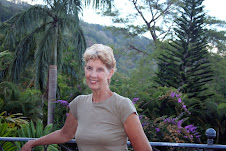
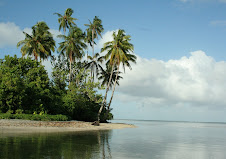
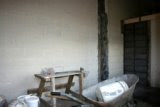

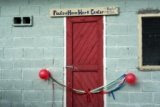
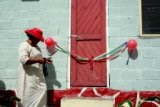
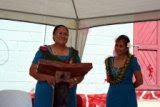
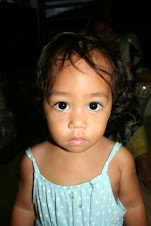
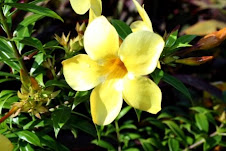
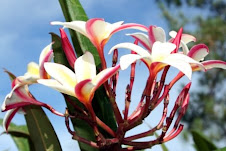
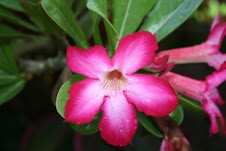

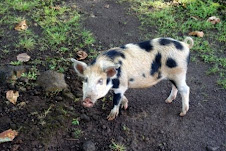

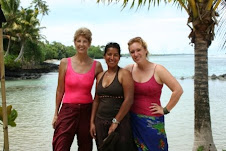

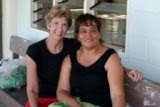

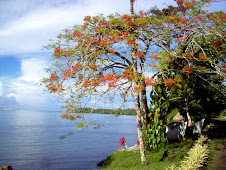
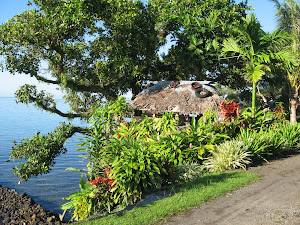
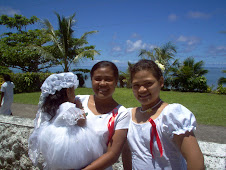
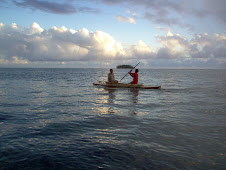

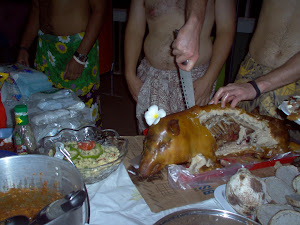
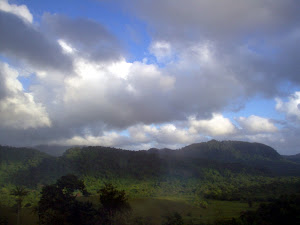
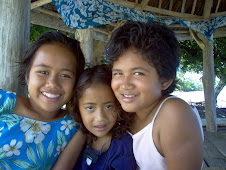.jpg)
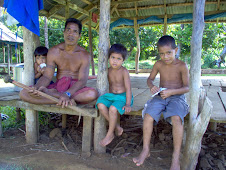



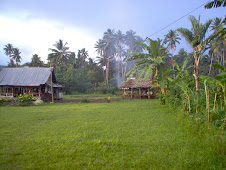



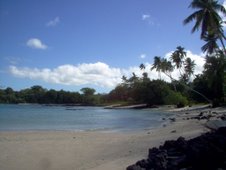
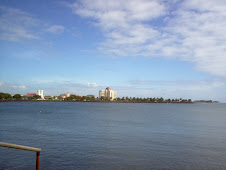

2 comments:
This post was fascinating! Reading all the history was great, and the idea of seeing 50 Samoan firedancers at once must have been awe inspiring. You really hit a great moment in time in a great place in time.
I have been reading your blog from time to time as well as some of the other PCV blogs. This one was particularly fascinating to me as I am a product of an American Naval officer and a Samoan girl. I was born in the late 40's in Leone, still have relatives there but have not met them. I came to the states soon after. Have always wanted to return to learn some of the culture I was denied. I would like to correspond with you if I could.
Post a Comment